Carpal tunnel syndrome (CTS) is the most common nerve entrapment disorder worldwide. CTS symptoms arise from compression of the median nerve within the carpal tunnel, a passage created by the wrist bones and the transverse carpal ligament near the base of the thumb.
The median nerve roots are situated in the neck at the junction of C5-T1. The nerve travels down the upper arm and forearm, and through the carpal tunnel to innervate the hand and fingers. Within the carpal tunnel, the median nerve shares space with nine flexor tendons that bend the fingers and move the thumb. Inflammation of the synovial tissues that surround the flexor tendons reduces the tunnel space, placing pressure on the median nerve and producing pain, numbness and dysfunction.
Carpal tunnel symptoms can arise from median nerve compression anywhere along its path, rendering most conventional treatment approaches ineffective. Symptoms may also arise from hypersensitization of the median nerve related to trauma or overuse, requiring specialized carpal tunnel treatment.

Many doctors are quick to recommend surgery to quickly alleviate carpal tunnel symptoms, but surgery does not guarantee long-term relief. Many patients have persistent symptoms post-op, or symptoms that gradually reappear over time. Subsequent surgeries may not produce better results.
Surgical carpal tunnel release options include open or endoscopic surgery. During the procedure, the surgeon cuts the transverse carpal ligament (CTL) on the palm side of the carpal tunnel to take pressure off the median nerve. While this may reduce symptoms and increase dexterity, the procedure undermines the function of the CTL.
The TCL serves as a structural stabilizer for the carpal tunnel, and provides a pulley for the flexor tendons by anchoring the thenar and hypothenar muscles to enhance hand strength. It also provides wrist proprioception. While severing the ligament may provide temporary symptom relief, the procedure undermines optimal hand and wrist function.
Conservative treatment of CTS encompasses strategies for reducing inflammation, releasing entrapped nerves, eliminating myofascial trigger points and densifications, and restoring nerve gliding. Holistic treatment strategies are minimally invasive and substantially less expensive and risky than carpal tunnel release surgery.
or
Dr. Lev Kalika, NYDNRehab’s clinical director, has over 15 years of clinical experience, working with pain syndromes, neuropathies and movement disorders. His dedication to finding drug-free solutions that treat the patient and not just the symptoms has made Dr. Kalika a premier healthcare provider in NYC.
Dr. Kalika is an expert in diagnostic ultrasonography, with multiple scientific articles to his credit. The NYDNRehab clinic features the highest resolution expert-grade ultrasound equipment available.
Dr. Kalika’s unique and proprietary approach to carpal tunnel treatment includes ultrasound-guided dry needling, electromagnetic transduction therapy, percutaneous neuromodulation therapy, and radial and focused shockwave therapy. Non-invasive extracorporeal shockwave therapy (ESWT) is one of the most effective treatments for carpal tunnel syndrome.
Dr. Kalika specializes in the treatment of peripheral neuropathies of the hand and arm. His research and expertise in dry needling and regenerative therapies, and his mastery of diagnostic ultrasonography, set him apart as a leader in alternative solutions for carpal tunnel rehab in NYC.
Carpal tunnel symptoms are brought on by compression of the median nerve — a long nerve that travels from your neck, all the way down your arm. Many doctors are quick to diagnose carpal tunnel syndrome based on symptoms alone, without considering other potential causes. This can lead to ineffective treatment that prolongs your pain and costs you time and money.
In some cases, despite symptoms in the wrist and hand, median nerve compression is not within the tunnel itself, but further up the arm in the upper pronator teres of the forearm, under the lacertus fibrosus near the elbow, or in the brachial plexus of the shoulder. In such cases, carpal tunnel release surgery is completely ineffective.

At NYDNRehab, we use high resolution diagnostic ultrasound for carpal tunnel to view the median nerve from end to end, in real time, and with the patient in motion. High-resolution ultrasonography offers multiple advantages over other imaging modalities for diagnosing CTS. It is portable, non-invasive, painless, and allows for visualization of changes in muscle innervation and blood flow. We can visualize the entire path of the median nerve to look for compression or stretching within the tunnel, or anywhere along its path.
Ultrasound imaging lets us identify the exact location of nerve entrapment, ensuring that our treatment protocol produces the most effective results.

Most people take everyday mobility for granted until an injury occurs or pain sets in. Sometimes pain and reduced mobility seem to arise out of nowhere, with no apparent cause of onset. Regardless of whether your pain is caused by trauma or by something less obvious, tensegrity plays a key role.
Tensegrity refers to tensile integrity – a state where a system of individual components is held together under continuous elastic tension. In the human body, tensegrity is created by the myofascial system, the network of muscles and fascia that work together to produce, control, and guide forces, and to hold the body’s various organs and structures in place during movement.
Tensegrity can be disrupted when myofascial tissues are injured or damaged in some way. When that happens, nerves and blood vessels can become entrapped, preventing them from gliding among other structures and producing pain. At the same time, the elastic tension that governs joint alignment and controls movement becomes compromised, creating motor deficits that undermine mobility and stability.
Many doctors do not understand the crucial role of the myofascial system in preventing pain syndromes, movement disorders, and disease. In fact, most medical doctors have no idea how to correct myofascial dysfunction or even recognize it as a factor. They simply treat pain symptoms with medications and eventually recommend surgery.
At NYDNRehab, we understand that the body’s systems work together as an integrated whole, and that treating pain is not enough to eliminate its source. We use dynamic high-resolution ultrasound to explore the myofascial system in real time. Ultrasound imaging lets us visualize muscles, fascia, nerves and other structures in motion, to identify places where tensegrity has been disrupted.
Once we identify the problem, we use the most advanced therapeutic approaches to restore myofascial integrity and promote tissue healing.
Identifying and treating underlying issues prior to beginning physical therapy is key to getting fast and effective results. Failure to pre-treat your condition can completely undermine your treatment protocol, and in some cases, your condition may even worsen.
Obstacles to physical therapy success include:
At NYDNRehab, we use a broad range of regenerative technologies and integrative therapeutic approaches to resolve issues that can stand in the way of successful physical therapy. Our staff is certified in a diverse array of holistic treatment methodologies, and our one-on-one treatment sessions are personalized, based on your unique diagnostic profile.
Once we pre-treat your damaged tissues and eliminate compensation patterns, your body will be ready to begin physical therapy.
Conventional medical treatment for carpal tunnel syndrome involves night-time splinting, steroid injections, reduced activity and nerve gliding exercises. When those approaches fail to resolve the condition, surgery — called carpal tunnel release — is often recommended.
During this procedure, median nerve pressure is relieved by cutting the transverse carpal ligament, to create more room for the median nerve and tendons. However, carpal release surgery only addresses the symptoms, without resolving the underlying causes of carpal tunnel syndrome. If nerve compression occurs higher up the arm, tunnel release surgery may be a complete failure.At NYDNRehab, we use the latest technologies and innovative therapies to provide fast and effective relief for carpal tunnel syndrome. Your treatment protocol may include physical therapy for carpal tunnel, along with one or more of our regenerative carpal tunnel rehab options.
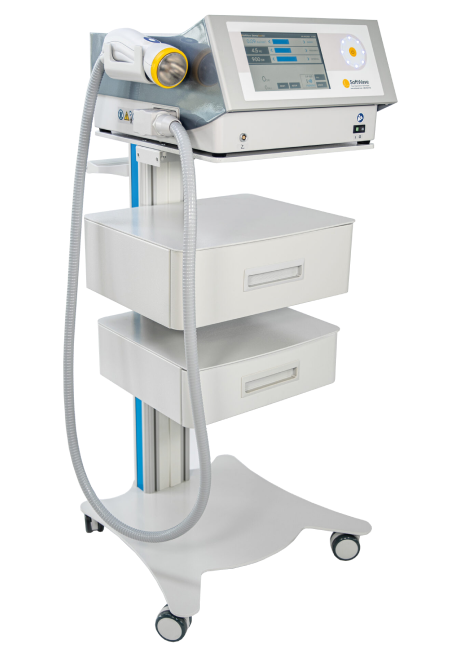
SoftWave is a groundbreaking regenerative mechanotransduction technology that accelerates tissue healing. Its patented electro-hydraulic applicator delivers high-speed soundwaves that can penetrate up to six inches in depth. SoftWave’s defocused and linear focused shockwaves recruit maximum stem cells to the treatment site to promote healing. SoftWave’s wider and deeper penetration using defocused energy is a preferred treatment option for a broad spectrum of conditions, ranging from orthopedic injuries to pelvic health. SoftWave is the only unfocused shockwave technology currently available. According to recent research, SoftWave defocused waves combined with focused and radial shockwaves have maximum regenerative potential.
MyACT is a new type of focused shockwave technology that allows for deeper compression of the focused waves. Its higher frequency allows for precise neuro modulation under ultrasound guidance, with a special linear head for treating myofascial pain. MyACT transforms the mechanical energy of shockwaves into biochemical signals that precisely target damaged tissues. Most injuries involve more than one tissue type. When used together, our advanced shockwave technologies enable us to specifically target multiple tissue types with the most effective shockwave treatment.
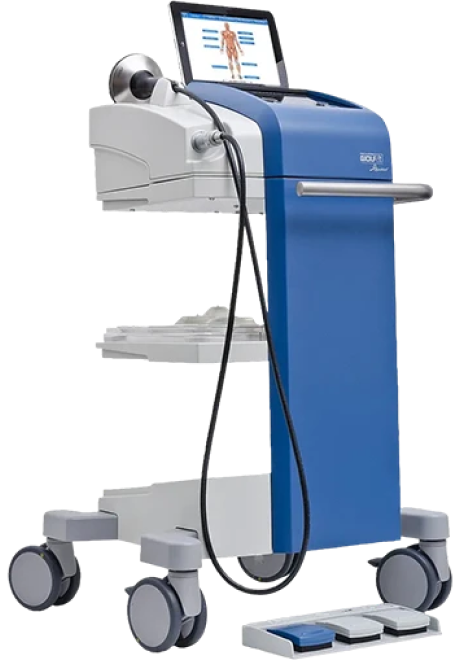

Focused ESWT is used as a regenerative treatment for damaged tendon, muscle and bone tissue. This technology produces high frequency sound waves to stimulate the body’s own reparative mechanisms. It is especially effective for chronic degenerative tendon disorders and myofascial pain syndrome.
EMTT transmits high energy magnetic pulses to targeted tissues that synchronize with the body’s own magnetic fields, triggering a regenerative response. EMTT waves can penetrate deep tissues to target difficult-to-reach tendons, muscles, bones and nerves.
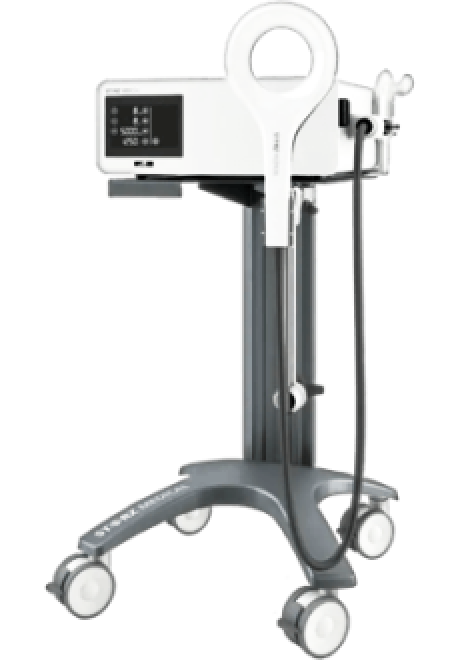
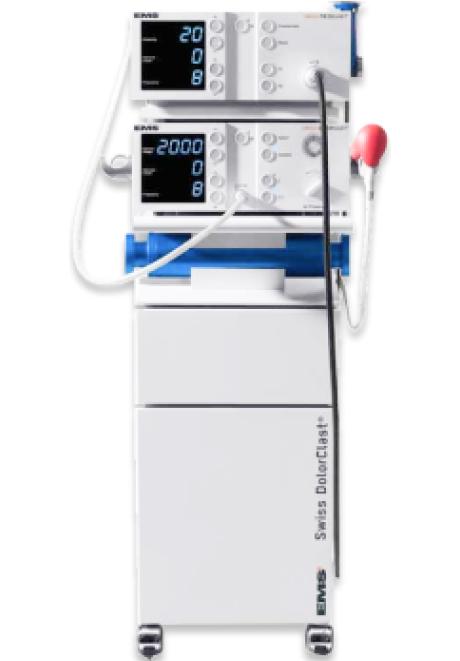
EPAT, sometimes called defocused shock wave therapy, is not a true shockwave. It uses mechanical pressure waves to enhance blood circulation, improving oxygen and nutrient delivery to muscle and fascia tissues, but has minimal regenerative properties.The mechanical properties of EPAT make it especially effective for fascial manipulation in combination with focused shockwaves. We combine EPAT with different types of shockwaves for holistic treatment, without additional cost to the patient.
HEIT delivers high-intensity magnetic pulses to peripheral nerve tissues, to stimulate neuroplasticity. We leverage this FDA-approved methodology to treat pain and regenerate nerve fibers, for enhanced motor control.
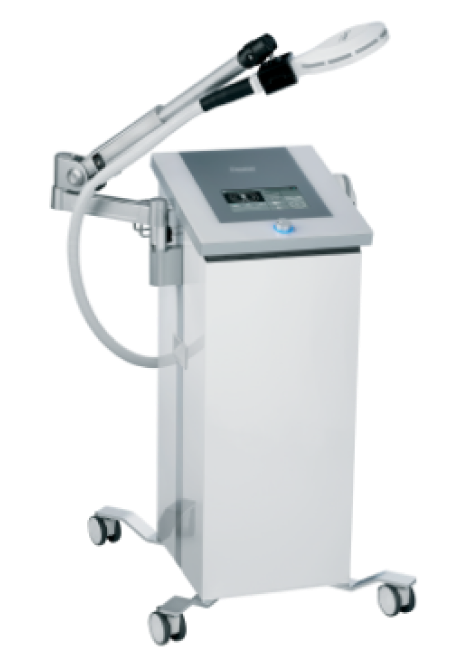
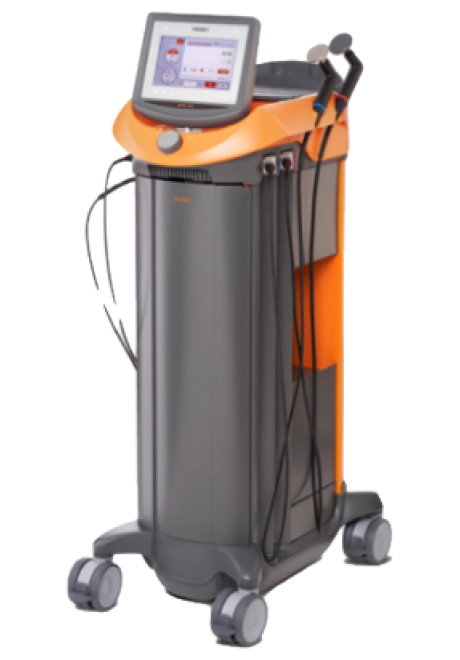
INDIBA is a form of TECAR therapy that helps to restore the ionic charge of damaged cells, for faster injury healing and rehabilitation.
NESA generates a low-frequency electrical current of intermittent and cyclical stimuli that soothes hypersensitized nerves and restores optimal signaling between the autonomic nervous system and the brain. We leverage this FDA-approved methodology to treat pain and regenerate nerve fibers, to enhance motor control.
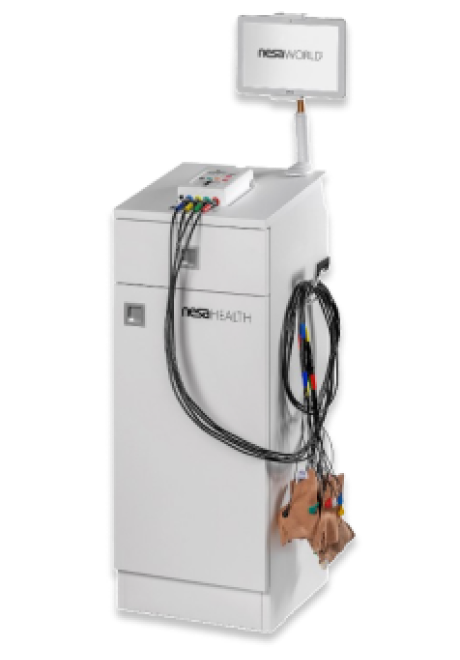
Injection therapies use orthobiologic solutions that stimulate cellular repair by either nourishing or irritating the targeted cells. Guidance by ultrasound ensures that the injected substances hit their mark, for maximum effectiveness.

PRP therapy uses a sample of the patient’s own whole blood, which is spun in a centrifuge to extract a high concentration of platelets. When injected into damaged tissues, PRP initiates tissue repair by releasing biologically active factors such as growth factors, cytokines, lysosomes and adhesion proteins. The injected solution stimulates the synthesis of new connective tissues and blood vessels. PRP can help to jump-start tendon healing in chronic injuries and accelerate repair in acute injuries.
Alpha 2 macroglobulin (A2M) is a naturally occurring blood plasma protein that acts as a carrier for numerous proteins and growth factors. As a protease inhibitor, A2M reduces inflammation in arthritic joints and helps to deactivate a variety of proteinases that typically degrade cartilage.
Prolotherapy uses a biologically neutral solution to irritate stubborn tissues, triggering the body’s innate healing mechanisms to grow new normal tendon, ligament and muscle fibers.
Condition injuries often involve fascial tissue that has become densified and/or formed adhesions, entrapping nerves and blood vessels, causing pain and restricting movement. Hydrodissection is a procedure where a saline solution is injected into densified fascia under ultrasound guidance. The solution works by separating fascial layers and freeing up entrapped nerves and blood vessels. We often use hydrodissection in conjunction with manual fascial manipulation.

During PENS treatment, filament-thin needles are inserted through the skin into muscle tissue adjacent to the targeted nerve. A low frequency electrical current is then delivered via the inserted needles to stimulate the dysfunctional nerve. PENS normalizes nerve activity, improves brain plasticity and optimizes muscle recruitment patterns. This therapy is so effective that patients typically need only 4-6 treatment sessions.
At NYDNRehab, we treat the whole patient, not just their symptoms. We never use one-size-fits-all rehab protocols or antiquated recovery timelines. We believe that every injury is unique, and treatment should be based on a holistic approach that factors in the patient’s unique profile.
Once we have successfully pre-treated damaged tissues, we can begin one-on-one physical therapy to restore strength and stability, optimize mobility, and re-establish optimal neuromuscular pathways and muscle coordination patterns.

Your back-to-sports physical therapy protocol may include sport-specific training to optimize motor skills and restore peak athletic performance. We carefully monitor patient progress with ultrasound imaging to confirm complete recovery.
Carpal tunnel syndrome is mainly caused by inflammation. Chronic inflammation can become a dangerous condition that ultimately affects your cardiovascular system and undermines your metabolic health. There are several actions you can take right away to prevent inflammation and reduce your risk of carpal tunnel syndrome and metabolic disease.
